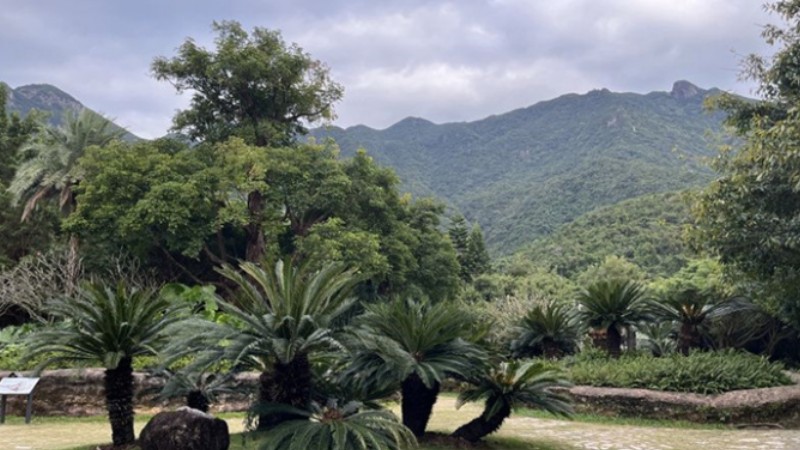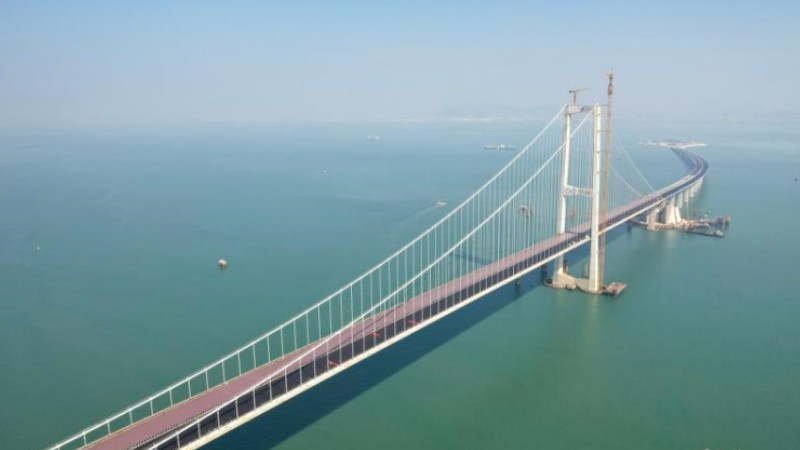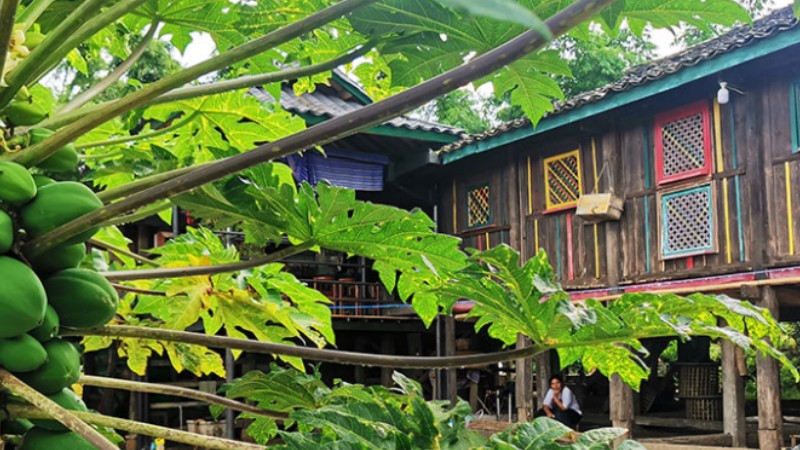Business booms at Xinjiang border ports
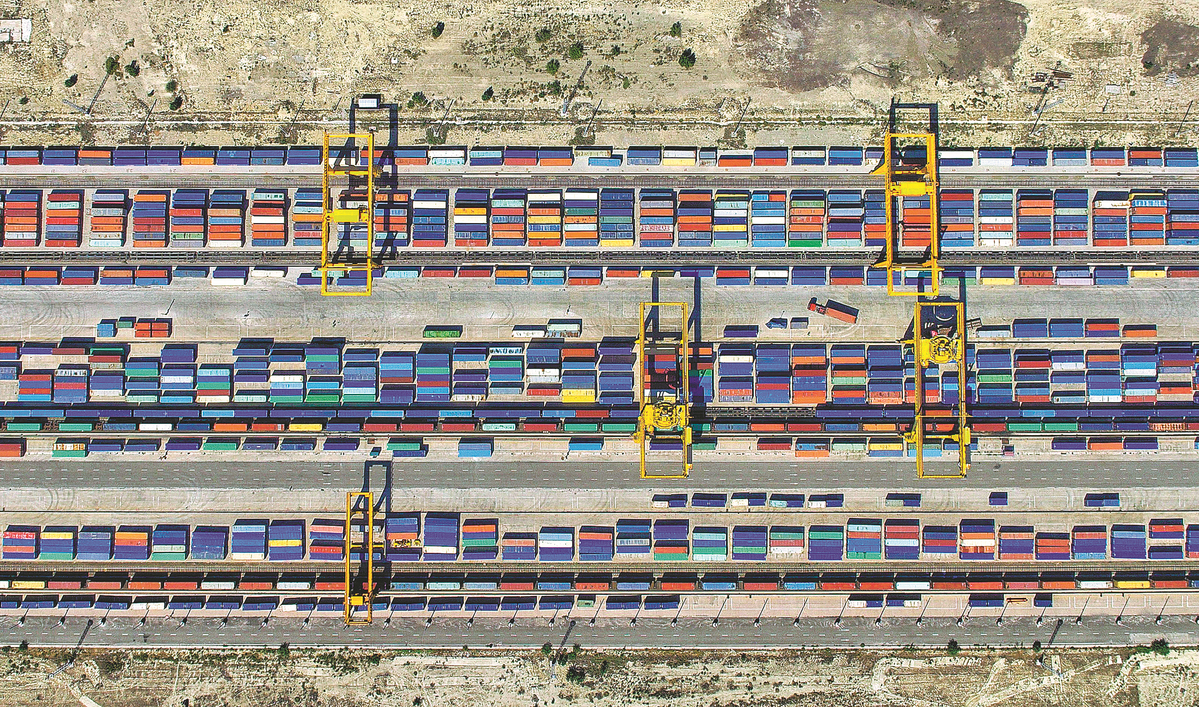
China-Europe freight trains carrying goods line up at the border port of Horgos. ZHAO GE/XINHUA
Preferential policies pave way for commercial success
A solitary border outpost on the edge of the vast desert has been transformed into a pivotal hub for the Silk Road Economic Belt.
As a result of this dramatic change, Alashankou Port, which is situated in the remote northwest corner of the Xinjiang Uygur autonomous region, is benefiting from the numerous opportunities offered by the Belt and Road Initiative.
A border city in Bortala Mongolian autonomous prefecture, Alashankou, which is also known as Alataw Pass, is 12 kilometers from Dostyk Port in Kazakhstan.
Alashankou lies at the western exit in China to the New Eurasian Land Bridge, one of six major corridors envisioned by the BRI. The land bridge starts from the port city of Lianyungang, Jiangsu province, and ends in the Dutch port of Rotterdam.
Li Jianglin, vice-mayor of Alashankou, said that by serving as a gateway to Central Asia and Europe, Alataw Pass is the shortest, quickest and most cost-effective international trade route along the Silk Road Economic Belt.
Rail links through Alataw Pass to Europe, known for their stability, efficiency and speed, have attracted a significant volume of domestic and international cargo, Li said.
Since China-Europe Railway Express services started operating in 2011, the number of freight trains passing through the port annually has rocketed from an initial 17 to nearly 6,000.
A total of 113 operational routes have been established for the rail link, covering 25 Chinese provinces and regions, and 21 countries. The trains transport some 200 types of goods, including automobiles and parts, cotton yarn and timber.
Known as the "windy city", Alashankou is battered by gale-force winds for more than 180 days each year. Despite the challenging weather conditions, business at the port continues to surge, driven by the dedication of its employees, who work day and night to ensure the smooth passage of freight trains.
Against a backdrop of howling gales, dockworker Bai Zhaoxin deftly operated a stacking machine to transfer cargo containers, a necessary task, as China and Kazakhstan have different railway gauges. Within one hour, some 55 containers had been reloaded.

Goods are transferred at Horgos railway station. ZHAO GE/XINHUA
The harsh climate used to make outdoor operations near-impossible, but Bai said that due to upgrading work carried out at the port, the situation has greatly improved.
Now, with indoor reloading warehouses in use, cargo containers can be seamlessly transferred each day, which has significantly improved transportation efficiency, he added.
In 2017, some 700 to 750 containers a day could be handled at the port, but its daily reloading capacity now stands at nearly 950 containers, Bai said.
"Every day, I handle a multitude of containers, I feel honored to act as a gatekeeper for this vital route on the Belt and Road Initiative," he added.
Li, the deputy mayor, said that in addition to the reloading warehouses, a series of infrastructure projects have been put into operation in recent years. They include a total of 94 broad-gauge and standard-gauge rail lines, a bulk-grain rail line, and an oil warehouse.
A series of measures have also been introduced at the port to facilitate clearance, reducing the transit time for imported goods by four hours, and also lowering transportation costs, Li said.
As of Nov 3, cargo throughput at the port reached 22.38 million metric tons, up by 5.1 percent year-on-year, Li said, adding that last year, the port's import and export trade volume reached 318.33 billion yuan ($44.87 billion).

A technician examines flaxseed oil produced at a factory in Alashankou, Xinjiang. LI XIN/XINHUA
Key gateway
Horgos Port in Ili Kazakh autonomous prefecture, another booming border port in Xinjiang, is located nearly 280 km south of Alataw Pass.
A historical gateway, Horgos translates in Mongolian as "the place where camel caravans pass", and in Kazakh as "the place where wealth accumulates".
From January to October, an estimated 6,433 China-Europe freight trains passed through Horgos Port, a rise of 9.8 percent year-on-year.
Local officials have said repeatedly that if railways can be compared to arteries, then roads bear comparison to capillaries.
Chen Pengde, deputy head of Horgos Customs, said Horgos road port is the longest-established, highest-capacity and most comprehensively equipped first-class land port in China.
In the first three quarters of this year, the road port's import and export volume reached about 1.36 million tons, up by about 120 percent year-on-year.
Local statistics show that as of Nov 3, vehicle exports through the port exceeded 100,000, representing year-on-year growth of more than 177 percent.
Hu Laijie, a senior official at the Horgos Port Administration, said Horgos is the largest land port for China's vehicle exports.
Gu Haifeng, manager of a logistics company in Horgos, seized the opportunity to leave Zhejiang province to find new business opportunities.
Due to increasing exports, Gu's company has transported more than 2,000 vehicles to European and Central Asian markets since May.
As customers from Kazakhstan, Russia and Belarus favor Chinese cars, several new energy vehicle brands, including Li Auto, Geely and Zeekr, sell well in these markets, Gu said.
Car transporters loaded with vehicles made in China can complete clearance procedures at Horgos Port within two hours, he said.
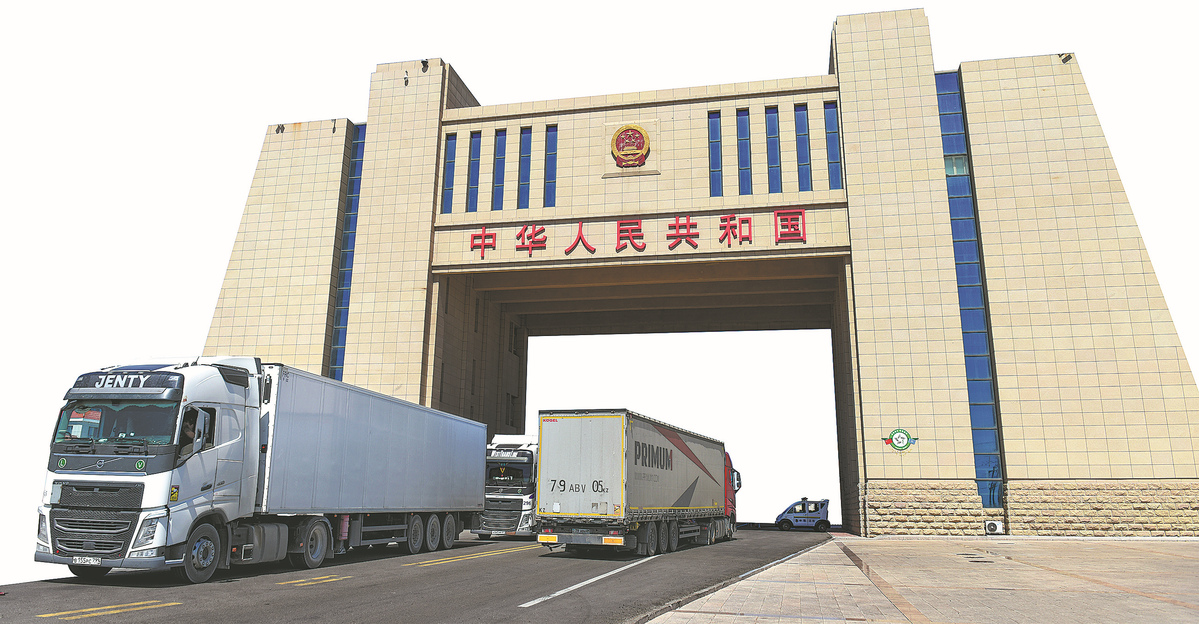
Trucks pass through the border between China and Kazakhstan at Alashankou Port in Xinjiang. DING LEI/XINHUA
In recent years, measures such as a classification policy and the introduction of a public information service platform at Horgos Port have greatly accelerated the customs clearance process.
Salamat Abdilda, 43, a Kazakh truck driver, said the round trip between Horgos and Almaty in Kazakhstan used to take five or six days, but it can now be completed in two days.
Five years ago, with trade between China and Kazakhstan increasing, Abdilda invested in a 20-metric-ton truck and started a cross-border transportation business.
Abdilda transports goods to China every three days, making seven or eight round trips a month between the two countries. He said Chinese clothing and daily necessities are exceptionally popular in Kazakhstan.
A comprehensive bonded zone established at Horgos Port has attracted foreign trade enterprises and fostered cross-border trade and greater openness. The zone was introduced to make better use of the port's strategic location and take advantage of preferential policies such as tax incentives and streamlined customs procedures.
Zhu Hongjian, an official with the zone's management committee, said that since the start of this year, more than 300 newly registered enterprises have moved into the zone, and their business includes warehousing and logistics, cross-border e-commerce, and financial leasing.
The first foreign enterprise to settle in the zone was Russian food processing company Golden Katyusha. Since 2017, the company has imported wheat flour and rapeseed oil from Novosibirsk, Russia, to process into food products, including noodles, edible oils and cookies.
Iurii Basargin, an executive at Golden Katyusha, said the short distance between Novosibirsk and Horgos, along with efficient customs clearance procedures, enable the materials to arrive at the zone within two days.
He added that with a favorable taxation policy, he is confident about doing business in Horgos.
The company imports nearly 500 tons of wheat and 100 tons of rapeseed oil every month, Basargin said. After a three-year business suspension due to the COVID-19 pandemic, its noodle processing factory, which reopened in September, has already received orders totaling about 300 tons from cities such as Chongqing and Chengdu, the capital of Sichuan province.
Basargin said the Chinese market is appealing and promising, adding, "We are exploring it step by step."
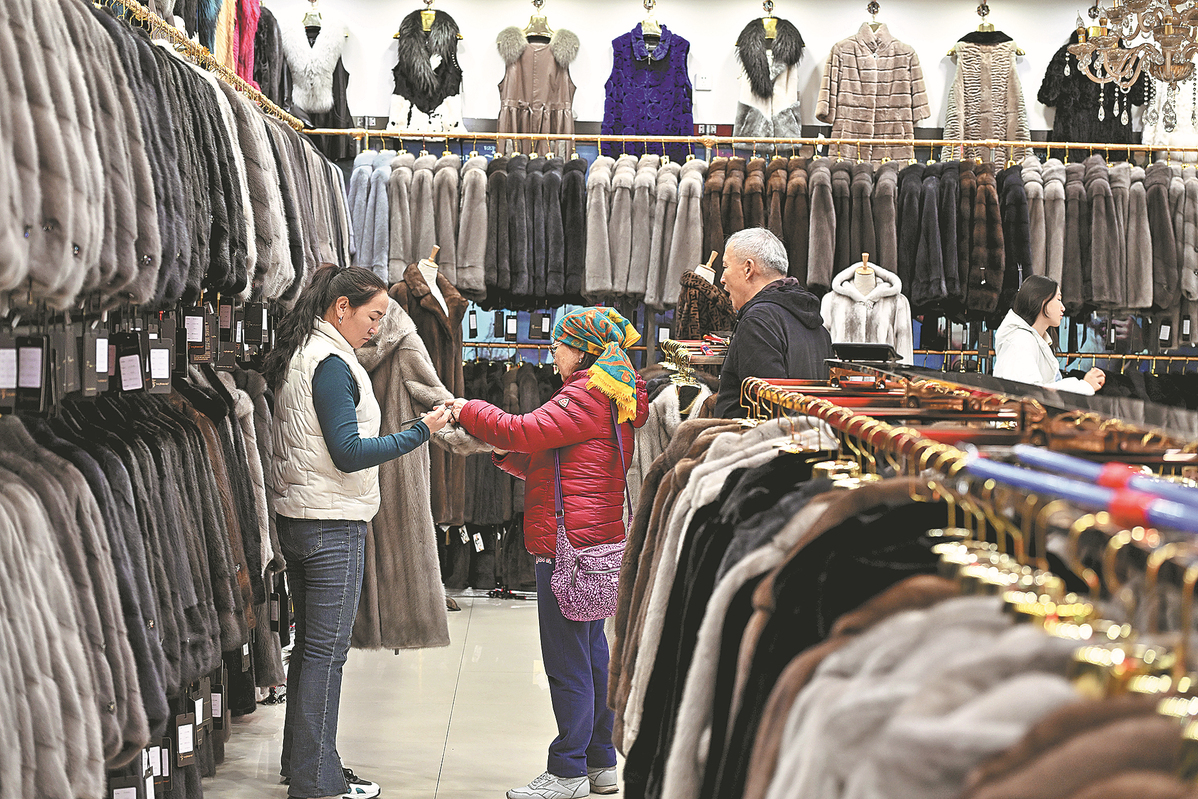
Visitors to Horgos, Xinjiang Uygur autonomous region, shop for clothes. LI XIN/XINHUA
Bright prospects
On Nov 1, the Xinjiang Pilot Free Trade Zone, the first in China's northwestern border regions, officially started operations.
The zone, which includes areas of Horgos, is expected to support core area development of the BRI, play a significant role in building a "golden channel" between Asia and Europe, and act as a bridgehead for China's westward opening up.
Hu, the Horgos Port Administration official, said, "This is an added bonus for Horgos, which is already an open platform.
"We will introduce more favorable measures to attract businesses to invest in Horgos, and guarantee their operations."
In recent days, representatives from numerous enterprises have visited Horgos to explore potential business opportunities, with a keen focus on understanding policies associated with the free trade zone, Hu said.
Local statistics show that in just 10 days, 12 enterprises signed contracts to invest a total of 12.6 billion yuan in Horgos.
On Nov 3, Bank CenterCredit, a Kazakh commercial bank, officially established a hub for international traders at the China-Kazakhstan Horgos International Border Cooperation Center.
The center straddles the China-Kazakhstan border and allows citizens of the two countries and certain other nations to enter and exit without visas, provided they have valid identification documents.
The bank is the first foreign lender to settle in the region since the establishment of the free trade zone, which is poised to provide more comprehensive cross-border financial services to Chinese and Kazakh enterprises and residents.
Staff member Ayazhan Tolegenova said some 500 individuals and 10 enterprises from Kazakhstan have already opened accounts with the bank.
She added that many Chinese companies have also shown an interest in the bank's competitive interest rates for deposits.
Photos
Related Stories
- SCO Forum "Year of Tourism 2023" opens in Xinjiang
- Kashgar to facilitate trade with key areas
- GT Voice: Bigger global production role to help Xinjiang defy US ban
- Chinese vice premier urges central SOEs to further assist Xinjiang's development
- Snow-covered Danxia landform in Xinjiang
- Pakistani businessman: 'Xinjiang is like my home'
Copyright © 2023 People's Daily Online. All Rights Reserved.






